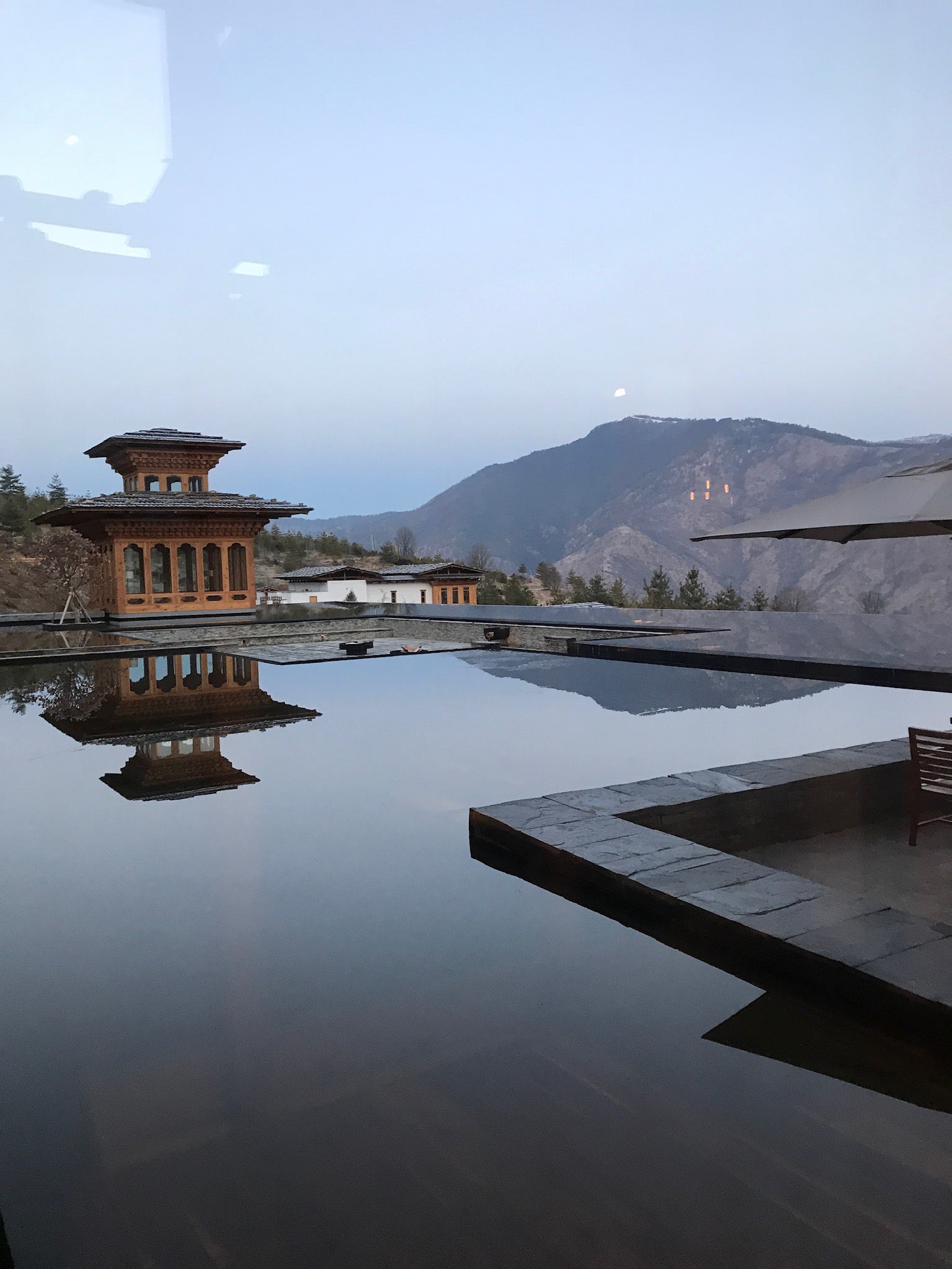
Bhutan
Traveled and written by Camilla Catlin
Camilla is the founder of Global Patina, an Independent Affiliate of The Local Foreigner.
Follow her @globalpatina

If you’re anything like me, you have a travel wish-list that never seems to get any shorter. Despite traveling constantly for my job, the rate of adding new destinations significantly outpaces the rate of checking them off. Almost exactly a year ago however, I had the opportunity to visit a place that wasn’t on my bucket list – the tiny Himalayan kingdom of Bhutan. In a way, the fact that I knew so little about it made my time there even more magical and full of surprises.

A deeply spiritual Buddhist country, Bhutan was essentially “closed” to tourism until 1974. Even today, visiting feels a little bit like stepping back in time, but with cell phones. Many Bhutanese wear traditional dress, and aside from Thimpu (the capital) the villages look the same as they have for centuries. The monarchy is forward-thinking yet purposeful in preserving their culture and traditions and the King and Queen are both impossibly stunningly good looking.

Part of my misconception about Bhutan was that it was only a spiritual/wellness destination. And although that’s certainly part of the appeal, I loved its active outdoorsy side. We hiked every day; in many cases walking from village to village, soccer ball in hand for maximum interaction. We would visit temples, stop for picnics and admire the incredible views. Then we would return to our lodge for an evening of spa treatments and incredible food. We went river-rafting, learned Bhutanese archery and even spent a night glamping under the stars eating s’mores. One morning we woke at dawn to attend prayers in Gangtey Gonpa (monastery) and then were treated to the most incredible breakfast in a sunny courtyard while we observed the bustle of the youngest monks cleaning their rooms. Each day was different and active, which is why I think that Bhutan is a perfect destination for families with older kids. We saw plenty of honeymooners as well as older couples, but the whole time I wished that I had my kids with me. Our guides were so cool and engaging, and there was an activity to suit every taste.

The hotel situation is literally insane. Gorgeous mountain lodges by Aman or Six Senses are in every valley, along with some independent gems like Gangtey Lodge which ranks up there as one of my all-time favorite hotels (saying a lot). I’m not a big fan of cookie-cutter luxury; and the lodges in Bhutan truly felt special and authentic to me. Understated wood and stone interiors were warmed by crackling fireplaces and epic valley views. They are all deeply involved in their local communities and sustainability is a tremendous focus. While some travelers prefer to stick with one brand throughout their time in Bhutan and follow a “circuit” of all Amans or Six Senses for example, I really enjoyed mixing it up a bit. I have my favorite lodges in each valley, and I loved exploring the differences between them. Most are quite small, with some only having eight rooms, so the experience is highly personal and intimate.

The highlight of my trip was when our little group attended a Tshechu (festival) in Punakha, with traditional dancers in impossibly colorful costumes acting out the story of one of Bhutan’s most revered gurus. There was chanting and pageantry and dancing and so much more that I didn’t understand, but we spent literally five intoxicating hours gawking at it all. Our guides patiently dressed us in loaner Bhutanese kiras and ghos, which helped us blend in with the locals - not at all - but certainly made us feel special. These festivals happen monthly in Bhutan, so when choosing an itinerary make sure that you’re aware of the dates. To me attendance at a Tshechu should be mandatory for all visitors – it really is that magical.


A few logistical points to consider:
- It’s hard to get there. There are no direct flights from the US & the best connections are through Delhi or Bangkok. The main airport in Paro is in a narrow valley surrounded by scary-looking mountains and only 20 or so pilots are licensed to fly there. Usually multiple approaches are made to land, with the crowd of locals on the ground placing bets on how many times the plane will have to circle before it lands. It’s all very amusing and jolly once you make it down, but the reality in the air can be a little stressful. First, the pilot tells you that you’re passing Mt. Everest and when you see it close-up and at eye level, you make a mental note not to climb it. Phew, crossed off my list! Then the approach is signaled by very dramatic classical music played loudly. Is this meant to distract? Not sure, but it’s genius and certainly sets the mood.
- You will spend a lot of time in a car. Bhutan has invested heavily in their roads and most are in very good condition (which is a recent change). Still, some trips can take up to 4-5 hours along winding roads through mountain passes. There are stops along the way and j’adore a good road trip, but it’s something to keep in mind. The beauty of Bhutan is experienced through the unique aspects of it’s different valleys, so it’s a “moving-around” kind of trip. One doesn’t go to Bhutan and choose a home base; one does a circuit. Other than driving, there is the option to take short internal flights between some of the valleys, as well as a helicopter. These range in price and usually the logistics and sequence of your itinerary will dictate what makes the most sense. I’ll say it now though – get yourself up in a helicopter at some point.
- You need to spend more than a week in Bhutan. Given the remoteness of the country, the time that it takes to get around once you’re there and the beauty and uniqueness of the different valleys, I recommend at least 8 days on the ground in order to experience Bhutan fully. I was there for eleven days and only got to four out of the five valleys. I like to be thorough, so that missed valley still irks me, but if you’re pressed for time you could get away with visiting three. Bhutan rewards those who go slowly and don’t rush through a checklist.
- Bhutan is difficult to pack for. As a year-round destination there are distinct seasons, with temperatures ranging from 30 degrees in the winter up to 80 degrees in the summer. Each of the valleys has its own microclimate as well, so temperatures can vary widely between them. When I went in February last year, the skies were super clear & blue and there was a bit of snow on the ground in some valleys, while it was t-shirt weather in others. You need to pack hiking clothes, spa clothes, lodgey loungey clothes and so many infernal layers. I hate it when you ask someone what to wear and they say “layers” as if that’s a helpful answer, but Bhutan is layer-land so just go with it. March to May and September to November is considered “high season”, and of course keep in mind the festival calendar.
- You can’t just show up and wander. Bhutan requires a visa of every traveler, which is organized by the entity that is hosting you (usually your hotel or guiding service). The government has purposely focused on the luxury market in order to avoid the backpacker & hostel culture, so budget accordingly. The good news is that, like going on safari or a cruise, nearly everything (your guides, transportation, lodging, food) is included. So, you pay once up front and then you’re done with it and you don’t need to stress over how many smoothies your kids are ordering when you’re not looking. Honestly, I think that it’s an incredible value given the personalization, depth and uniqueness of the experience.

I could write all day long and still not feel like I have adequately described what made that trip to Bhutan so incredible. The combination of the warmth of the people coupled with the spectacular landscape is certainly a major part of it. Taking a helicopter up to the Jomolhari Base Camp was an unforgettable experience for me, as was the hike through rhododendron forest listening to our guides explain that we might cross paths with a yeti. Don’t add it to your bucket-list, just go.
Kelly's Packing List for Bhutan

Heroine Sport hoodie, $135, Isdin Eryfotona sun screen $66; Tory Sport $200Adidas Originals $130, Live the Process sports bra, $98; Cotopaxi backpack $200, Bear "Explore" supplements, $65 Net a Porter, Corroon folding nylon duffel $165; We over Me leggings $105.





